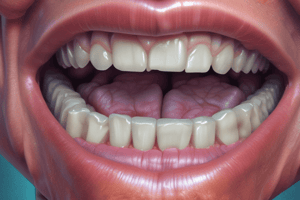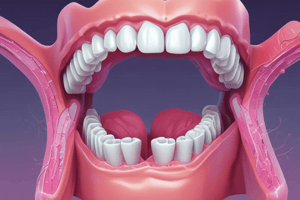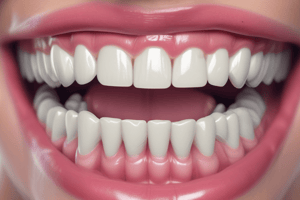Podcast
Questions and Answers
The classification system includes eight groups related to dental disorders.
The classification system includes eight groups related to dental disorders.
True (A)
A causal gene has been identified for 90% of the entities analyzed.
A causal gene has been identified for 90% of the entities analyzed.
False (B)
The group 'TÊTECOU' is a French collaborative network involved in this classification.
The group 'TÊTECOU' is a French collaborative network involved in this classification.
True (A)
The classification system is intended solely for dental research and not for clinical use.
The classification system is intended solely for dental research and not for clinical use.
Systematic literature analysis yielded 408 entities with dental disorders.
Systematic literature analysis yielded 408 entities with dental disorders.
The classification only covers syndromic disorders without mentioning isolated disorders.
The classification only covers syndromic disorders without mentioning isolated disorders.
Enamel and dentin issues are classified as separate groups within the system.
Enamel and dentin issues are classified as separate groups within the system.
Critical evaluations of the definitions and classifications are discouraged.
Critical evaluations of the definitions and classifications are discouraged.
Dental anomalies can only occur during adulthood.
Dental anomalies can only occur during adulthood.
The multidisciplinary group of experts defines dental anomalies.
The multidisciplinary group of experts defines dental anomalies.
Complete nosologies of dental disorders have been entirely published.
Complete nosologies of dental disorders have been entirely published.
Existing terminology of dental anomalies was developed without any database analysis.
Existing terminology of dental anomalies was developed without any database analysis.
Dental anomalies reflect disturbances in odontogenesis.
Dental anomalies reflect disturbances in odontogenesis.
Data regarding dental anomalies can only be sourced from a single nomenclature.
Data regarding dental anomalies can only be sourced from a single nomenclature.
Tooth initiation is one of the stages that can be disturbed, leading to dental anomalies.
Tooth initiation is one of the stages that can be disturbed, leading to dental anomalies.
The completion of root development only occurs after the eruption of the last third molar.
The completion of root development only occurs after the eruption of the last third molar.
Oligodontia-colorectal cancer syndrome is linked to the AXIN2 gene.
Oligodontia-colorectal cancer syndrome is linked to the AXIN2 gene.
Ectodermal dysplasia 1 is an autosomal recessive condition.
Ectodermal dysplasia 1 is an autosomal recessive condition.
There are five different types of selective tooth agenesis identified.
There are five different types of selective tooth agenesis identified.
The GJB6 gene is associated with Ectodermal dysplasia 2, Clouston type.
The GJB6 gene is associated with Ectodermal dysplasia 2, Clouston type.
Taurodontia is associated with congenital absence of teeth.
Taurodontia is associated with congenital absence of teeth.
Ectodermal dysplasia includes conditions related to hair, nails, and teeth.
Ectodermal dysplasia includes conditions related to hair, nails, and teeth.
Böök syndrome is characterized by severe hyperhidrosis of the hands and feet.
Böök syndrome is characterized by severe hyperhidrosis of the hands and feet.
Ectodermal dysplasia 10B is an autosomal dominant condition.
Ectodermal dysplasia 10B is an autosomal dominant condition.
The MSX1 gene is linked to both tooth agenesis and ectodermal dysplasia types.
The MSX1 gene is linked to both tooth agenesis and ectodermal dysplasia types.
Dermoodontodysplasia is related to abnormal development of several ectodermal structures.
Dermoodontodysplasia is related to abnormal development of several ectodermal structures.
Ectodermal dysplasia with natal teeth is termed Turnpenny type.
Ectodermal dysplasia with natal teeth is termed Turnpenny type.
The PAX9 gene is associated with selective tooth agenesis type 3.
The PAX9 gene is associated with selective tooth agenesis type 3.
SKI is a gene associated with Ectodermal dysplasia 10A.
SKI is a gene associated with Ectodermal dysplasia 10A.
Deafness, congenital, and onychodystrophy is inherited in an autosomal recessive manner.
Deafness, congenital, and onychodystrophy is inherited in an autosomal recessive manner.
Progeroid short stature with pigmented nevi is associated with intellectual disability.
Progeroid short stature with pigmented nevi is associated with intellectual disability.
Axenfeld-Rieger syndrome, type 1 is linked to the gene PITX2.
Axenfeld-Rieger syndrome, type 1 is linked to the gene PITX2.
Ectodermal dysplasia of trichoodontoonychial type has no reported manifestations related to hearing.
Ectodermal dysplasia of trichoodontoonychial type has no reported manifestations related to hearing.
Coffin-Lowry syndrome is inherited in an X-linked dominant manner.
Coffin-Lowry syndrome is inherited in an X-linked dominant manner.
Short stature, onychodysplasia, and facial dysmorphism are typical manifestations of Short stature, onychodysplasia, facial dysmorphism, and hypotrichosis.
Short stature, onychodysplasia, and facial dysmorphism are typical manifestations of Short stature, onychodysplasia, facial dysmorphism, and hypotrichosis.
Andersen syndrome is associated with mutations in the KCNJ2 gene.
Andersen syndrome is associated with mutations in the KCNJ2 gene.
Telecanthus is listed under eye diseases.
Telecanthus is listed under eye diseases.
Blepharocheilodontic syndrome is inherited in an autosomal recessive manner.
Blepharocheilodontic syndrome is inherited in an autosomal recessive manner.
Dermatoosteolysis, Kirghizian type has been linked to specific joint issues.
Dermatoosteolysis, Kirghizian type has been linked to specific joint issues.
The PAX3 gene is associated with Waardenburg syndrome, type 1.
The PAX3 gene is associated with Waardenburg syndrome, type 1.
Chromosome 6pter-p24 deletion syndrome is associated with significant hearing loss.
Chromosome 6pter-p24 deletion syndrome is associated with significant hearing loss.
Pilodental dysplasia has normal sweating and fingernails as part of its manifestations.
Pilodental dysplasia has normal sweating and fingernails as part of its manifestations.
Wolf-Hirschhorn syndrome has an autosomal dominant inheritance pattern.
Wolf-Hirschhorn syndrome has an autosomal dominant inheritance pattern.
Cleft lip/palate-ectodermal dysplasia syndrome is associated with gene NECTIN1.
Cleft lip/palate-ectodermal dysplasia syndrome is associated with gene NECTIN1.
Cranioectodermal dysplasia 1 is caused by mutations in the IFT43 gene.
Cranioectodermal dysplasia 1 is caused by mutations in the IFT43 gene.
EEC syndrome-1 manifests with features such as anhidrotic ectodermal dysplasia and cleft lip.
EEC syndrome-1 manifests with features such as anhidrotic ectodermal dysplasia and cleft lip.
The primary genetic factor for Rapp-Hodgkin syndrome is associated with the TP63 gene.
The primary genetic factor for Rapp-Hodgkin syndrome is associated with the TP63 gene.
ADULT syndrome includes various features like split hands and feet.
ADULT syndrome includes various features like split hands and feet.
Hay-Wells syndrome is solely inherited in an autosomal recessive manner.
Hay-Wells syndrome is solely inherited in an autosomal recessive manner.
Ectodermal dysplasia with immune deficiency is associated with the IKBKG gene.
Ectodermal dysplasia with immune deficiency is associated with the IKBKG gene.
Dilated cardiomyopathy with woolly hair is a recessively inherited condition.
Dilated cardiomyopathy with woolly hair is a recessively inherited condition.
Ectodermal dysplasia/skin fragility syndrome primarily features skin blistering.
Ectodermal dysplasia/skin fragility syndrome primarily features skin blistering.
Acral-renal-ectodermal-dysplasia-lipoatrophic-diabetes (AREDYLD) has a known genetic basis.
Acral-renal-ectodermal-dysplasia-lipoatrophic-diabetes (AREDYLD) has a known genetic basis.
Cerebellar ataxia and ectodermal dysplasia can occur simultaneously.
Cerebellar ataxia and ectodermal dysplasia can occur simultaneously.
The gene associated with Cranioectodermal dysplasia 4 is WDR35.
The gene associated with Cranioectodermal dysplasia 4 is WDR35.
Incontinentia pigmenti is inherited in an X-linked dominant fashion.
Incontinentia pigmenti is inherited in an X-linked dominant fashion.
Dysosteosclerosis is associated with the gene SLC29A3.
Dysosteosclerosis is associated with the gene SLC29A3.
Kabuki syndrome is an autosomal recessive disorder.
Kabuki syndrome is an autosomal recessive disorder.
Johanson-Blizzard syndrome is characterized by pancreatic insufficiency.
Johanson-Blizzard syndrome is characterized by pancreatic insufficiency.
Ellis-van Creveld syndrome is linked to the EVC1 and EVC2 genes.
Ellis-van Creveld syndrome is linked to the EVC1 and EVC2 genes.
Hypogonadotropic hypogonadism 1 is not associated with anomalies of the hypothalamic-pituitary axis.
Hypogonadotropic hypogonadism 1 is not associated with anomalies of the hypothalamic-pituitary axis.
Sotos syndrome is primarily inherited in an autosomal recessive manner.
Sotos syndrome is primarily inherited in an autosomal recessive manner.
Rothmund-Thomson syndrome is associated with the RECQL4 gene.
Rothmund-Thomson syndrome is associated with the RECQL4 gene.
Weyers acrodental dysostosis involves manifestations such as nail dystrophy and postaxial polydactyly.
Weyers acrodental dysostosis involves manifestations such as nail dystrophy and postaxial polydactyly.
Alagille syndrome is characterized by an abundance of intrahepatic bile ducts.
Alagille syndrome is characterized by an abundance of intrahepatic bile ducts.
Carpenter syndrome is associated with obesity and intellectual disability.
Carpenter syndrome is associated with obesity and intellectual disability.
The gene associated with Hypogonadotropic hypogonadism 2 is FGFR1.
The gene associated with Hypogonadotropic hypogonadism 2 is FGFR1.
Branchiooculofacial syndrome causes conductive hearing loss.
Branchiooculofacial syndrome causes conductive hearing loss.
Acrofacial dysostosis, Palagonia type, is inherited in an autosomal dominant manner.
Acrofacial dysostosis, Palagonia type, is inherited in an autosomal dominant manner.
Hypogonadotropic hypogonadism 3 with anosmia is linked to the gene PROKR2.
Hypogonadotropic hypogonadism 3 with anosmia is linked to the gene PROKR2.
Flashcards
Dental Agenesis
Dental Agenesis
The absence of one or more teeth, typically due to genetic factors or developmental problems.
Supernumerary Teeth
Supernumerary Teeth
The presence of extra teeth beyond the normal number, often found in the front of the mouth.
Dental Size and Shape
Dental Size and Shape
Abnormalities in the size and shape of teeth, such as abnormally small or large teeth, or unusual tooth forms.
Enamel Anomaly
Enamel Anomaly
Signup and view all the flashcards
Dentin Anomaly
Dentin Anomaly
Signup and view all the flashcards
Dental Eruption Anomaly
Dental Eruption Anomaly
Signup and view all the flashcards
Periodontal and Gingival Anomaly
Periodontal and Gingival Anomaly
Signup and view all the flashcards
Tumor-like Anomaly
Tumor-like Anomaly
Signup and view all the flashcards
Dental Anomalies
Dental Anomalies
Signup and view all the flashcards
Odontogenesis
Odontogenesis
Signup and view all the flashcards
What are the stages of tooth development?
What are the stages of tooth development?
Signup and view all the flashcards
What is a nosology?
What is a nosology?
Signup and view all the flashcards
Syndromic Dental Disorders
Syndromic Dental Disorders
Signup and view all the flashcards
Isolated Dental Disorders
Isolated Dental Disorders
Signup and view all the flashcards
HPO (Human Phenotype Ontology)
HPO (Human Phenotype Ontology)
Signup and view all the flashcards
What are some examples of databases used to classify dental anomalies?
What are some examples of databases used to classify dental anomalies?
Signup and view all the flashcards
Tooth Agenesis
Tooth Agenesis
Signup and view all the flashcards
Oligodontia
Oligodontia
Signup and view all the flashcards
Anodontia
Anodontia
Signup and view all the flashcards
Hypodontia
Hypodontia
Signup and view all the flashcards
Ectodermal Dysplasia
Ectodermal Dysplasia
Signup and view all the flashcards
Hypohidrotic Ectodermal Dysplasia
Hypohidrotic Ectodermal Dysplasia
Signup and view all the flashcards
Taurodontia
Taurodontia
Signup and view all the flashcards
What are the common symptoms of Ectodermal Dysplasia?
What are the common symptoms of Ectodermal Dysplasia?
Signup and view all the flashcards
What is the gene responsible for X-linked Hypohidrotic Ectodermal Dysplasia?
What is the gene responsible for X-linked Hypohidrotic Ectodermal Dysplasia?
Signup and view all the flashcards
What is the inheritance pattern of Ectodermal Dysplasia 1?
What is the inheritance pattern of Ectodermal Dysplasia 1?
Signup and view all the flashcards
What is the protein affected in Ectodermal Dysplasia 3 (Witkop type)?
What is the protein affected in Ectodermal Dysplasia 3 (Witkop type)?
Signup and view all the flashcards
What is the main feature of Böök syndrome?
What is the main feature of Böök syndrome?
Signup and view all the flashcards
What are the main features of Dermoodontodysplasia?
What are the main features of Dermoodontodysplasia?
Signup and view all the flashcards
What distinguishes Trichodental Dysplasia from other Ectodermal Dysplasias?
What distinguishes Trichodental Dysplasia from other Ectodermal Dysplasias?
Signup and view all the flashcards
What is the inheritance pattern of Odontoonychodermal Dysplasia?
What is the inheritance pattern of Odontoonychodermal Dysplasia?
Signup and view all the flashcards
Wolf-Hirschhorn syndrome
Wolf-Hirschhorn syndrome
Signup and view all the flashcards
Cleft lip/palate-ectodermal dysplasia syndrome (CLPED1)
Cleft lip/palate-ectodermal dysplasia syndrome (CLPED1)
Signup and view all the flashcards
Cranioectodermal dysplasia
Cranioectodermal dysplasia
Signup and view all the flashcards
EEC syndrome-1
EEC syndrome-1
Signup and view all the flashcards
Orofacial cleft 8
Orofacial cleft 8
Signup and view all the flashcards
ADULT syndrome
ADULT syndrome
Signup and view all the flashcards
Ectodermal dysplasia, ectrodactyly, and macular dystrophy
Ectodermal dysplasia, ectrodactyly, and macular dystrophy
Signup and view all the flashcards
Ectodermal dysplasia-syndactyly syndrome 1
Ectodermal dysplasia-syndactyly syndrome 1
Signup and view all the flashcards
Hay-Wells syndrome
Hay-Wells syndrome
Signup and view all the flashcards
Limb-mammary syndrome
Limb-mammary syndrome
Signup and view all the flashcards
Odontotrichoungual-digital-palmar syndrome
Odontotrichoungual-digital-palmar syndrome
Signup and view all the flashcards
Incontinentia pigmenti
Incontinentia pigmenti
Signup and view all the flashcards
Ectodermal dysplasia, hypohidrotic, with immune deficiency
Ectodermal dysplasia, hypohidrotic, with immune deficiency
Signup and view all the flashcards
Cardiomyopathy, dilated, with woolly hair and keratoderma
Cardiomyopathy, dilated, with woolly hair and keratoderma
Signup and view all the flashcards
Acral-renal-ectodermal-dysplasia-lipoatrophic-diabetes (AREDYLD)
Acral-renal-ectodermal-dysplasia-lipoatrophic-diabetes (AREDYLD)
Signup and view all the flashcards
AD inheritance
AD inheritance
Signup and view all the flashcards
AR inheritance
AR inheritance
Signup and view all the flashcards
XLD inheritance
XLD inheritance
Signup and view all the flashcards
IC inheritance
IC inheritance
Signup and view all the flashcards
Gene/locus
Gene/locus
Signup and view all the flashcards
Protein name & function
Protein name & function
Signup and view all the flashcards
Phenotype
Phenotype
Signup and view all the flashcards
MIM number
MIM number
Signup and view all the flashcards
Orphanet number
Orphanet number
Signup and view all the flashcards
What is the relationship between dental anomalies and syndromes?
What is the relationship between dental anomalies and syndromes?
Signup and view all the flashcards
What are some examples of dental anomalies associated with syndromes?
What are some examples of dental anomalies associated with syndromes?
Signup and view all the flashcards
What are some databases used to classify dental anomalies?
What are some databases used to classify dental anomalies?
Signup and view all the flashcards
What is the significance of classifying dental anomalies?
What is the significance of classifying dental anomalies?
Signup and view all the flashcards
What are some examples of dental anomalies?
What are some examples of dental anomalies?
Signup and view all the flashcards
What does AR stand for in genetics?
What does AR stand for in genetics?
Signup and view all the flashcards
What does AD stand for in genetics?
What does AD stand for in genetics?
Signup and view all the flashcards
What is XLD inheritance?
What is XLD inheritance?
Signup and view all the flashcards
What does 'inheritance' refer to in genetics?
What does 'inheritance' refer to in genetics?
Signup and view all the flashcards
What is 'phenotype' in genetics?
What is 'phenotype' in genetics?
Signup and view all the flashcards
What is a 'gene'?
What is a 'gene'?
Signup and view all the flashcards
What is a 'protein'?
What is a 'protein'?
Signup and view all the flashcards
What is 'osteopetrosis'?
What is 'osteopetrosis'?
Signup and view all the flashcards
What is 'chondrodysplasia'?
What is 'chondrodysplasia'?
Signup and view all the flashcards
What is 'ectodermal dysplasia'?
What is 'ectodermal dysplasia'?
Signup and view all the flashcards
What is 'intellectual disability'?
What is 'intellectual disability'?
Signup and view all the flashcards
What is 'facial dysmorphology'?
What is 'facial dysmorphology'?
Signup and view all the flashcards
What is 'platyspondyly'?
What is 'platyspondyly'?
Signup and view all the flashcards
What is 'polydactyly'?
What is 'polydactyly'?
Signup and view all the flashcards
Study Notes
Genetic Dental Disorders
- Dental anomalies are common in genetic disorders, acting as diagnostic markers.
- A classification system for genetic dental disorders was created to aid diagnosis.
- Definitions for common dental signs were developed through discussion among experts.
- The classification is based on the "TÊTECOU" network, which focuses on head and neck disorders.
Defining Dental Anomalies
- Analysis of existing terminology from databases (e.g., HPO, Orphanet) was used.
- The definitions supersede previous ones in similar morphology series.
- The classification prioritizes the dental anomaly, followed by other related medical features.
- Causative genes and links to OMIM and Orphanet nomenclatures are included.
Dental Anomaly Nosology(Table 1)
- The table details 408 different dental conditions.
- It lists the phenotype, MIM number, Orphanet number, inheritance pattern, corresponding genes, proteins, and associated clinical features for each condition.
- Various inheritance patterns (autosomal dominant, autosomal recessive, X-linked, etc.) are represented.
- Multiple genes and associated proteins are implicated in causing these conditions.
Tooth Anatomy and Morphology
- The oral cavity encompasses maxilla, mandible, muscles, glands, and related structures involved in oral functions.
- The oral cavity includes mucosa, tongue, teeth (crown, root, cementum), and periodontal tissues.
- Different types of oral mucosa exist (lining, masticatory, specialized).
- Dentition includes deciduous (primary) and permanent teeth.
- Deciduous have 20 teeth, and permanent have 32 teeth.
- FDI and ISO systems classify teeth based on location and type (incisors, canines, premolars, molars).
- The normal anatomy of teeth structures (crown, pulp, root and cementum), and associated supporting tissues is detailed.
Studying That Suits You
Use AI to generate personalized quizzes and flashcards to suit your learning preferences.
Related Documents
Description
This quiz explores an advanced classification system specifically created for dental disorders, highlighting the relationships between various dental anomalies and their causal genes. It emphasizes the syndromic disorders within the system and discusses the role of the French collaborative network 'TÊTECOU'. Dive into the nuances of enamel and dentin issues and how they are categorized.




